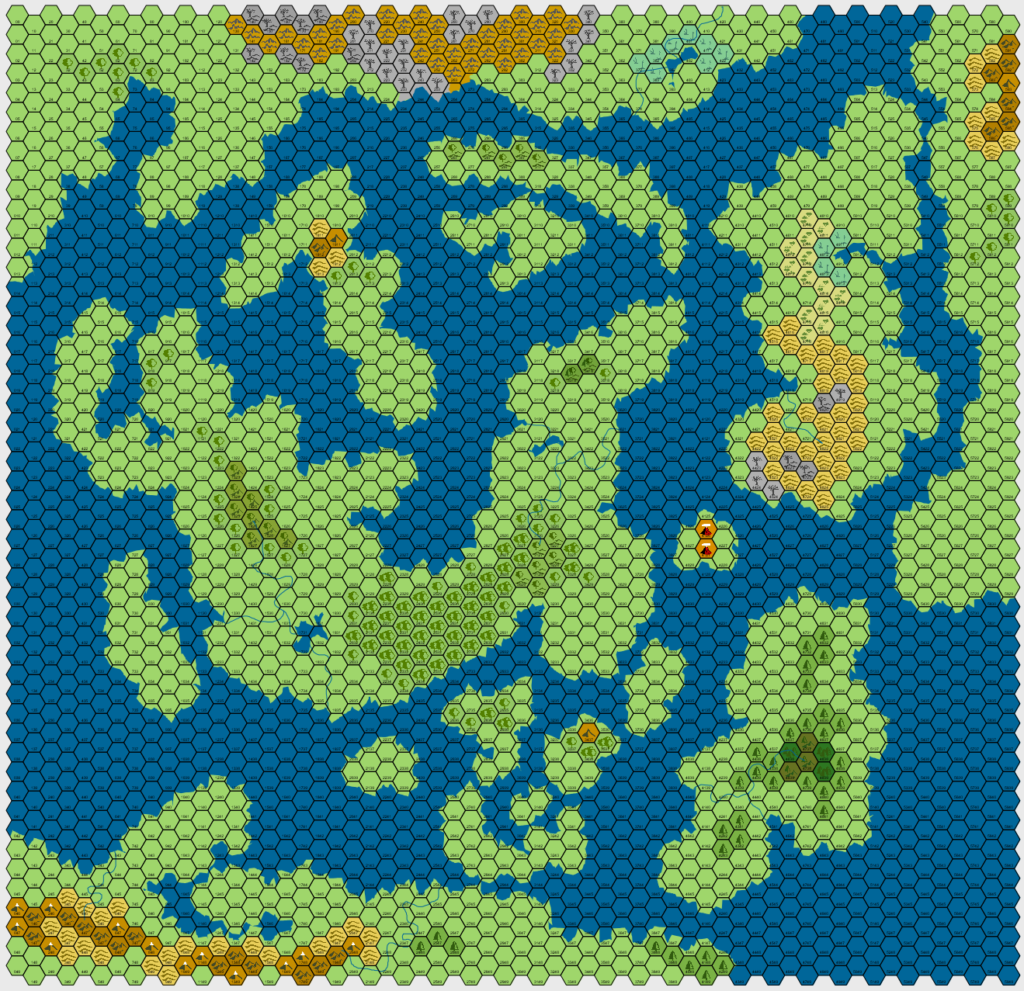This morning in the shower it hit me that in a region called “the Unlucky Isles,” with six kingdoms, only three of those kingdoms were fully contained within the Isles (the other three stretch off the map) — and one of those is “fantasy Switzerland.” Would that generate enough local conflict to fuel adventures?
But sitting down and looking at my map again, I saw that I could expand my plan to have disputed islands — originally, just one or two between Ahlsheyan and Brundir — to include a Brundir/Dominion disputed island in the north. And I figured that Rasu Miar, while it’s part of a nation that stretches off the map (Kadavis, to the east), is basically an island kingdom — so that’s four, not three. I’m feeling good about all of that.
So this evening I tucked into finishing the regional map, which needs cities in order to match the example in Worlds Without Number, plus a few more non-major-but-still-sizeable geographical features, like scattered woods and whatnot, for visual interest. After adding some terrain where I planned to put disputed claims, and some more because I liked how it looked, I turned on grid numbers:

Population figures
WWN presents some great back-of-the-napkin math for determining population figures, and then using those to back into number/size of cities, so I started there. I counted hexes by hand, ignoring the partial/ragged coastline hexes, and jotted down the ballpark population for each kingdom (or portion thereof which appears on the map, for the three that aren’t fully contained within the Isles).
- Arkestran Dominion, 287,000: 215 hexes not counting the Wastes = 430,000 = 43,000 in cities, but the portion on the map is lightly populated hinterlands, so that’s too high. Let’s say 287,000 = 29,000 in cities = no capital city here, so one major city of 10,000, plus 19,000 in other cities.
- Yealmark, 84,000: 41 hexes x 2,000 = 84,000 = 8,400 in cities = 2,800 in capital city, and 5,600 split between two other cities.
- Brundir, 840,000: about 420 hexes x 2,000 = 840,000 = 84,000 in cities = 28,000 in capital city, 14,000 in second-largest city, 42,000 in other cities.
- Kadavis, 248,000 on Rasu Miar, 266,000 in Kadavis proper: 165 hexes in Rasu Miar = 330,000 = 33,000 in cities, but the population is a little lower in this inhospitable place, so let’s say 248,000 = 25,000 in cities = no capital here, so 8,300 in major city, 4,200 in next-largest city, and 12,500 in other cities.
- …and 133 hexes of Kadavis proper on this map = 266,000 = 26,600 in cities = no capital city on this map, so 9,000 in major city, 4,400 in second-largest city, 13,200 in other cities.
- Meskmur, 230,000: 115 hexes x 2,000 = 230,000 = 23,000 in cities = 7,600 in capital city, 3,900 in second-largest city, 11,500 in other cities.
- Ahlsheyan, 550,000: 225 hexes on this map = 550,000 = 55,000 in cities = capital city isn’t on this map, so 18,000 in major city, 9,000 in second-largest city, 28,000 in other cities.
That would make the population of the Unlucky Isles 2.5 million people. That’s roughly equal to the population of medieval England in the early 12th century, which seems like the right ballpark. I’m starting to get a sense for the scope of this region, which is exciting.
I view 2.5 million as the upper bound. WWN notes that wilderness hexes don’t count, and until I have some cities in place and have drawn in some major roads, I won’t know even roughly how many wilderness hexes are in the Unlucky Isles. So I expect those stats (and maybe the number of cities) to go down a bit, at least in some of the kingdoms. (And I should note that WWN doesn’t have all this population stuff happening for the whole region at this stage — I’m electing to do it now because it’s fun, and because it keeps my map grounded so it can serve as a firm foundation for ongoing development.)
But for tonight I’m calling it here — after a surprisingly time-consuming amount of math and fiddling with cities — because it’s time to play Fortnite with the kiddo!
(This post is one of a series about worldbuilding with Worlds Without Number.)
